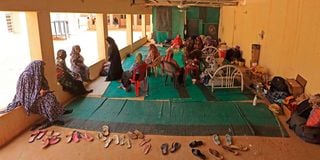
Women displaced by conflict sit at a mosque in Sudan's northern border town of Wadi Halfa near Egypt on September 12, 2023.
Sudan war started as a disagreement between allies: The Sudan Armed Forces led by Abdel Fattah al-Burhan, and the Rapid Support Forces led by Mohamed Hamdan Daglo ‘Hemedti’.
Now everyone is paying the price, through hunger and death.
More than 17 months later, the conflict has become complicated with efforts at ceasefire failing and new battlefronts opening up. A UN panel of investigators found that there was credible evidence to show war crimes had already occurred.
While the war has raised the death toll to more than 18,000, displacing more than 11 million others, the real burden is on the economy that was already fragile. The conflict has expanded to cover more than 70 percent of the country, with fighting spreading from Khartoum to Darfur and Kordofan in the west, the White Nile in the south, and the Gezira and Sennar states in the central and southwestern regions, taking with it casualties.
The conflict in Sudan has left about 25 million people, including more than 14 million children, in need of urgent humanitarian aid. According to United Nations reports, 17.7 million people, more than a third of the country’s population, are facing acute food insecurity, with 4.9 million on the brink of famine. The reports also indicated that over 8.6 million people—about 16 percent of the population—have been displaced from their homes since the conflict began.
Economic Devastation
Sudan’s economy is suffering heavily from the effects of the war. Economic experts estimate the destruction of assets to be between $500- $700 billion. The continuation of the conflict means a further contraction of national production and possibly a complete collapse of public revenues, which would significantly increase the economic losses.
The industrial sector is the hardest hit, with about 75 percent of its production units lost, followed by the services sector at 70 percent, and the agricultural sector at 65 percent. The war has also caused the destruction of key infrastructure, including bridges, dams, electricity, water, and fuel networks, as well as health, educational, and industrial facilities, markets, and citizens’ homes. Additionally, the environmental degradation and pollution resulting from the war have further exacerbated the crisis.
Mohamed Ibrahim, a Sudanese economist explained that the prolonged duration of the war could push Sudan towards complete collapse on all fronts.
He stated that “the growing inflation, coupled with the loss of key production sectors, will leave the country in a dire situation.” Ibrahim added that the biggest challenge will be rebuilding the vital infrastructure, a process that could take many years even with potential international interventions.
The country’s GDP has contracted by more than 40 percent, and public revenues have decreased by 80 percent, according to official data, forcing the government to resort to printing money in the absence of international funding. Inflation rates have exceeded 520 percent, according to the International Monetary Fund.
Unemployment has surged from 32.14 percent in 2022 to 47.2 percent in 2024, and the US Food Policy Institute predicts that 5 million jobs will be lost due to the war as most state and private sector institutions remain closed.
The prices of essential food commodities have more than tripled due to the disruption of supply chains and the collapse of the Sudanese pound. The exchange rate of the U.S. dollar fluctuates daily and is currently being traded at approximately 2,800 Sudanese pounds per dollar at the time of writing, compared to 600 pounds before the war broke out.
Banking Sector Collapse
The banking sector in Sudan is on the verge of collapse, with 100 branches of Sudanese banks looted and destroyed during the conflict. In Khartoum alone, 38 percent of the banks’ funds have been stolen.
Even the Central Bank of Sudan has not escaped the destruction, resulting in a severe liquidity crisis. Many banks are struggling to manage their debts, as major companies that borrowed significant amounts have been looted and destroyed, making it difficult for banks to collect these debts.
Impact on Other Sectors
Services: More than 60 percent of the country suffers from severe shortages in electricity, water, and telecommunications services, as the conflict has destroyed many of the main facilities and networks. Large areas of the capital and other cities have remained in complete darkness and without water since the early weeks of the conflict.
Health: The healthcare sector is on the verge of complete collapse, with over 60 percent of hospitals out of service. The Sudanese Minister of Health has estimated that around 11 billion US Dollars is needed to rehabilitate the health sector. Hundreds of patients with chronic diseases such as kidney disease and diabetes die daily due to the lack of access to hospitals and life-saving medications.
Education: About 19 million students have lost an entire academic year, as education at all levels has been entirely suspended since the war began. Over 70 percent of schools, universities, and other higher educational institutions in Khartoum have been partially or completely destroyed.
Buildings and Infrastructure: The heavy aerial and artillery bombardment has destroyed about 10 percent of residential buildings, 40 percent of markets, and 60 percent of vital buildings in the capital, including the Presidential Palace, parts of the Army General Command, as well as several museums, historical buildings, ministries, and government and private offices, some of which have been entirely burnt down.







